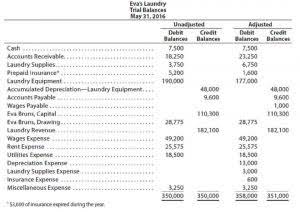
Similarly, the value of a company’s operating liabilities is equal to the sum of all operating liabilities less the value of all non-operating liabilities. Further, an example of a liability that would NOT qualify as an operating liability would be long-term debt, as debt is a financing activity. Current liabilities are used as a key component in several short-term liquidity list of operating liabilities measures. Below are examples of metrics that management teams and investors look at when performing financial analysis of a company. In addition, liabilities impact the company’s liquidity and, in the case of debt, capital structure. Also, if cash is expected to be tight within the next year, the company might miss its dividend payment or at least not increase its dividend.
- Read on to learn the definitions of liabilities, assets and expenses, as well as some common liabilities for small businesses.
- The monetary benefit provided by these assets comes in the form of interest income, yet a company could hypothetically continue conducting business as usual even if these securities were to be liquidated.
- These invoices are recorded in accounts payable and act as a short-term loan from a vendor.
- An account payable is usually a less formal arrangement than a promissory note for a current note payable.
- An invoice from the supplier (such as the one shown in Figure 12.2) detailing the purchase, credit terms, invoice date, and shipping arrangements will suffice for this contractual relationship.
Types of Assets
The good news is that for a loan such as our car loan or even a home loan, the loan is typically what is called fully amortizing. For example, your last (sixtieth) payment would only incur $3.09 in interest, with the remaining payment covering the last of the principle owed. This is done by adding back non-cash expenses like depreciation and amortization. Similar adjustments are made for non-cash expenses or income such as share-based compensation or unrealized gains from foreign currency translation. This includes anything that comes into and goes out of the company’s coffers.
What Is the Current Ratio?
Another way to think about burn rate is as the amount of cash acompany uses that exceeds the amount of cash created by thecompany’s business operations. Many start-ups have a highcash burn rate due to spending to start the business, resulting inlow cash flow. At first, start-ups typically do not create enoughcash flow to sustain operations. A note payable is a debt to a lender with specific repayment terms, which can include principal and interest. A note payable has written contractual terms that make it available to sell to another party.
What Is the Relationship Between Assets, Liabilities, and Shareholder’s Equity?
- This method was morecommonly used prior to the ability to do the calculations usingcalculators or computers, because the calculation was easier toperform.
- Next month, interestexpense is computed using the new principal balance outstanding of$9,625.
- Like assets, liabilities are originally measured and recorded according to the cost principle.
- The articles and research support materials available on this site are educational and are not intended to be investment or tax advice.
- Liabilities are listed on a company’s balance sheet and expenses are listed on a company’s income statement.
Short-term debts can include short-term bank loans used to boost the company’s capital. Overdraft credit lines for bank accounts and other short-term advances from a financial institution might be recorded as separate line items, but are short-term debts. The current portion of long-term debt due within the next year is also listed as a current liability. The annual interest rate is 3%, and you are required tomake scheduled payments each month in the amount of $400. You firstneed to determine the monthly interest rate by dividing 3% bytwelve months (3%/12), which is 0.25%. The monthly interest rate of0.25% is multiplied by the outstanding principal balance of $10,000to get an interest expense of $25.

Would you prefer to work with a financial professional remotely or in-person?
However, if a company has too much-working capital, some assets are unnecessarily being kept as working capital and are not being invested well to grow the company long term. Upgrading to a paid membership gives you access to our extensive collection of plug-and-play Templates designed to power your performance—as well as CFI’s full course catalog and accredited Certification Programs. We collaborate with business-to-business vendors, connecting them with potential buyers. In some cases, we earn commissions when sales are made through our referrals.

What Does a Company’s Net Cash Flow From Operating Activities Include?
Maintaining high liquidity is crucial for covering short-term liabilities, ensuring that a company has sufficient cash and assets that can be readily converted into cash. In contrast, long-term liabilities could be paid after one year and require low liquidity. A current liability is an amount owed by a company to its creditors that must be paid within one year or the normal operating cycle, whichever is longer. These advance payments are called unearned revenues and include such items as subscriptions or dues received in advance, prepaid rent, and deposits.
- Another way to think about burn rate is as the amount of cash a company uses that exceeds the amount of cash created by the company’s business operations.
- On the other hand, on-time payment of the company’s payables is important as well.
- The bond issuer (company) must pay a coupon (interest) based on coupon rate and face value.
- These liabilities are generally classified as current because the goods or services are usually delivered or performed within one year or the operating cycle (if longer than one year).
- Balance sheet critics point out its use of book values versus market values, which can be under or over-inflated.
- If the landscaping company provides part of the landscaping services within the operating period, it may recognize the value of the work completed at that time.
When a customer first takes out theloan, most of the scheduled payment is made up of interest, and avery small amount goes to reducing the principal balance. Overtime, more of the payment goes toward reducing the principalbalance rather than interest. An invoice from the supplier (such as the one shown in Figure 12.2) detailing the purchase, credit terms, invoicedate, and shipping arrangements will suffice for this contractualrelationship. In many cases, accounts payable agreements do notinclude interest payments, unlike notes payable. Car loans, mortgages, and education loans have an amortization process to pay down debt. Amortization of a loan requires periodic scheduled payments of principal and interest until the loan is paid in full.
What Are Some Common Examples of Current Liabilities?
It measures a company’s ability to pay short-term obligations with its current assets. Of all the financial statements issued by companies, the balance sheet is one of the most effective tools in evaluating financial health at a specific point in time. Consider it a financial snapshot that can be used for forward or backward comparisons. The simplicity of its design makes it easy to view the balances of the three major components with company assets on one side, and liabilities and owners’ equity on the other side. Shareholders’ equity is the net balance between total assets minus all liabilities and represents shareholders’ claims to the company at any given time.
Current liabilities are used by analysts, accountants, and investors to gauge how well a company can meet its short-term financial obligations. Typically, current liabilities are settled using the company’s current assets, which represent short-term uses of funds. Non-operating liabilities are items connected to financing activities and include debt repayable within the next 12 months and dividends announced but not paid.
